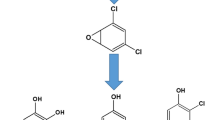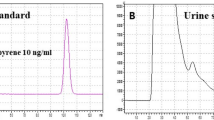Abstract
Introduction and aim
Biological monitoring of n-hexane (HEX) is based on the measurement of urinary 2,5-hexanedione (2,5-HD). In 2001, the American Conference of Governmental Industrial Hygienists modified the biological exposure index (BEI) for HEX and suggested measuring free urinary 2,5-HD (without hydrolysis) (3.5 μmol/l) instead of total 2,5-HD (acid hydrolysis). This BEI value was derived from four field studies that involved worker exposures to variable concentrations of HEX and other solvents. This study was undertaken to characterize, for 5 consecutive days, the relationship between HEX exposure (25 ppm and 50 ppm) and (1) 2,5-HD urinary excretion and (2) HEX in alveolar air.
Methods
Five volunteers (three women, two men) were exposed to HEX in an exposure chamber for 2 non-consecutive weeks (7 h/day). They were exposed to 50 ppm HEX, during the first week and to 25 ppm during the second week. Alveolar air and urine samples were collected at different intervals before, during and after the exposures. The concentration of unchanged HEX in alveolar air and the concentration of urinary 2,5-HD under three analytical conditions (with acid, or enzymatic hydrolysis and without hydrolysis) were measured.
Results
The results show that the mean concentrations of HEX in alveolar air were 18 ppm (25 ppm) and 37 ppm (50 ppm), which indicates that approximately 73% of inspired HEX was expired unchanged in alveolar air by the volunteers. The mean (± SD) concentrations of urinary 2,5-HD for the last 4 h of exposure at the end of the week (day 5) following exposure to 50 ppm HEX were 30.4 μmol/l (±7.8 μmol/l) (acid hydrolysis); 5.8 μmol/l (±1.0 μmol/l) (enzymatic hydrolysis); 6.2 μmol/l (±0.9 µmol/l) (without hydrolysis). Following the volunteers’ exposure to 25 ppm HEX, the urinary excretion concentrations were 15.2 μmol/l ± 1.9 μmol/l, 3.1 μmol/l ± 0.7 μmol/l and 3.7 μmol/l ± 0.5 μmol/l, respectively.
Conclusion
Both free urinary 2,5-HD and HEX in alveolar air measurements could be used for the biological monitoring of HEX. Between these two indicators, HEX in alveolar air is less variable than 2,5-HD in urine, but the sampling time is more critical. Therefore, biological monitoring of HEX based on the measurement of free urinary 2,5-HD is preferable to HEX in alveolar air. Additionally, we believe that the 2,5-HD values reported in this study better reflect the actual levels of exposure to HEX alone than what has been previously reported in studies that involved co-exposure to other solvents, and that the current BEI value for HEX is most likely more protective than what has been believed up until now.

Similar content being viewed by others
References
Abou-Donia MB, Makkawy HA, Graham DG (1982) The relative neurotoxicities of n-hexane, methyl n-butyl ketone, 2,5-hexanediol, and 2,5-hexanedione following oral or intraperitoneal administration in hens. Toxicol Appl Pharmacol 15;62:369–389
Alessio L, Berlin A, Dell’Orto A, Toffoletto F, Ghezzi I (1985) Reliability of urinary creatinine as a parameter used to adjust values of urinary biological indicators. Int Arch Occup Environ Health 55:99–106
American Conference of Governmental Industrial Hygienists (ACGIH) (2001) 2001 TLVs and BEIs for chemical substances and physical agents. Cincinnati, Ohio
Baldasseroni A, Bavazzano P, Li Donni V, Buiatti E, Lanciotti E, Lorini C, Toti S, Biggeri A (2003) Occupational exposure to n-hexane in Italy—analysis of a registry of biological monitoring. Int Arch Occup Environ Health 76260–266
Boeniger MF, Lowry LK, Rosenberg J (1993) Interpretation of urine results used to assess chemical exposure with emphasis on creatinine adjustments: a review. Am Ind Hyg Assoc J 54:615–627
Brugnone F, Perbellini L, Grigolini L, Apostoli P (1978) Solvent exposure in a shoe upper factory. Int Arch Occup Environ Health 42:51–62
Brugnone F, Maranelli G, Romeo L, Giuliari C, Gobbi M, Malesani F, Bassi G, Alexopoulos C (1991) Ubiquitous pollution by n-hexane and reference biological levels in the general population. Int Arch Occup Environ Health 63:157–160
Cardona A, Marhuenda D, Prieto MJ, Marti J, Periago JF, Sanchez JM (1996) Behaviour of urinary 2,5-hexanedione in occupational co-exposure to n-hexane and acetone. Int Arch Occup Environ Health 68:88–93
dos Santos CR, Meyer Passarelli MM, de Souza Nascimento E (2002) Evaluation of 2,5-hexanedione in urine of workers exposed to n-hexane in Brazilian shoe factories. J Chromatogr B Analyt Technol Biomed Life Sci 5;778:237–244
Fedtke N, Bolt HM (1987) The relevance of 4,5-dihydroxy-2-hexanone in the excretion kinetics of n-hexane metabolites in rat and man. Arch Toxicol, 61:131–137
Filser JG, Peter H, Bolt HM, Fedtke N (1987) Pharmacokinetics of the neurotoxin n-hexane in rat and man. Arch Toxicol 60:77–80
Graham DG, Amarnath V, Valentine WM, Pyle SJ, Anthony DC (1995) Pathogenetic studies of hexane and carbon disulfide neurotoxicity. Crit Rev Toxicol 25:91–112
Ichihara G, Saito I, Kamijima M, Yu X, Shibata E, ToidaM, Takeuchi Y (1998) Urinary 2,5-hexanedione increases with potentiation of neurotoxicity in chronic coexposure to n-hexane and methyl ethyl ketone. Int Arch Occup Environ Health 71:100–104
Iwata M, Takeuchi Y, HisanagaN, Ono Y (1984) Changes of n-hexane neurotoxicity and its urinary metabolites by long-term co-exposure with MEK or toluene. Int Arch Occup Environ Health 54:273–281
Kawai T, Mizunuma K, Yasugi T, Uchida Y, Ikeda M (1990) The method of choice for the determination of 2,5-hexanedione as an indicator of occupational exposure to n-hexane. Int Arch Occup Environ Health 62:403–408
Kawai T, Yasugi T, Mizunuma K, Horiguchi S, Uchida Y, Iwami O, Iguchi H, Ikeda M (1991a) 2-Acetylfuran, a confounder in urinalysis for 2,5-hexanedione as an n-hexane exposure indicator. Int Arch Occup Environ Health 63:213–219
Kawai T, Yasugi T, Mizunuma K, Horiguchi S, Uchida Y, Iwami O, Iguchi H, Ikeda M (1991b) Dose-dependent increase in 2,5-hexanedione in the urine of workers exposed to n-hexane. Int Arch Occup Environ Health 63:285–291
Kawai T, Yasugi T, Mizunuma K, Horiguchi S, Ikeda M (1992a) Urinalysis vs blood analysis, as a tool for biological monitoring of solvent exposure. Toxicol Lett 63:333–343
Kawai T, Yasugi T, Mizunuma K, Horiguchi S, Iguchi H, Uchida Y, Iwami O, Ikeda M (1992b) Comparative evaluation of urinalysis and blood analysis as means of detecting exposure to organic solvents at low concentrations. Int Arch Occup Environ Health 64:223–234
Kawai T, Miyama Y, Horiguchi S, Sakamoto K, Zhang ZW, Higashikawa K, Ikeda M (2000) Possible metabolic interaction between hexane and other solvents co-exposed at sub-occupational exposure limit levels. Int Arch Occup Environ Health 73:449–456
Laparé S, Tardif R, Brodeur J (1993) Effect of various exposure scenarios on the biological monitoring of organic solvents in alveolar air. I. Toluene and m-xylene. Int Arch Occup Environ Health64:569–580
Laparé S, Tardif R, Brodeur J (1995) Effect of various exposure scenarios on the biological monitoring of organic solvents in alveolar air. II. 1,1,1-Trichloroethane and trichloroethylene. Int Arch Occup Environ Health 67:375–394
Manini P, Andreoli R, Mutti A, Bergamaschi E, Franchini I (1999) Determination of free and glucuronated hexane metabolites without prior hydrolysis by liquid- and gas-chromatography coupled with mass spectrometry. Toxicol Lett 108:225–231
Mayan O, Teixeira JP, Pires AF (2001) Biological monitoring of n-hexane exposure in Portuguese shoe manufacturing workers. Appl Occup Environ Hyg 16:736–741
Mutti A, Falzoi M, Lucertini S, Arfini G, Zignani M, Lombardi S, Franchini I (1984) n-Hexane metabolism in occupationally exposed workers. Br J Ind Med 41:533–438
Perbellini L, Brugnone F, Pastorello G, Grigolini L (1979) Urinary excretion of n-hexane metabolites in rats and humans. Int Arch Occup Environ Health 42:349–354
Perbellini L, Brugnone F, Faggionato G (1981) Urinary excretion of the metabolites of n-hexane and its isomers during occupational exposure. Br J Ind Med 38:20–26
Perbellini L, Mozzo P, Brugnone F, Zedde A (1986) Physiologicomathematical model for studying human exposure to organic solvents: kinetics of blood/tissue n-hexane concentrations and of 2,5-hexanedione in urine. Br J Ind Med 43:760–768
Perbellini L, Pezzoli G, Brugnone F, Canesi M (1993) Biochemical and physiological aspects of 2,5-hexanedione: endogenous or exogenous product? Int Arch Occup Environ Health 65:49–52
Periago JF, Cardona A, Marhuenda D, Roel J, Villanueva M, Marti J, Luna A (1993) Biological monitoring of occupational exposure to n-hexane by exhaled air analysis and urinalysis. Int Arch Occup Environ Health 65:275–278
Shibata E, Huang J, Ono Y, Hisanaga N, Iwata M, Saito I, Takeuchi Y (1990) Changes in urinary n-hexane metabolites by co-exposure to various concentrations of methyl ethyl ketone and fixed n-hexane levels. Arch Toxicol 64:165–168
Shibata E, Johanson G, Lof A, Ernstgard L, Gullstrand E, Sigvardsson K (2002) Changes in n-hexane toxicokinetics in short-term single exposure due to co-exposure to methyl ethyl ketone in volunteers. Int Arch Occup Environ Health 75:399–405
Spencer PS, Schaumburg HH, Sabri MI, Veronesi B (1980) The enlarging view of hexacarbon neurotoxicity. Crit Rev Toxicol 7:279–356
Takeuchi Y, Hisanaga N, Oni Y, Shibata E, Saito I, Iwata M (1993) Modification of metabolism and neurotoxicity of hexane by co-exposure of toluene. Int Arch Occup Environ Health 65:S227–S230
Tardif R, Laparé S, Plaa GL, Brodeur J (1991) Effect of simultaneous exposure to toluene and xylene on their respective biological exposure indices in humans. Int Arch Occup Environ Health 63:279–284
Van Engelen JGM, Haan WR, Opdam JJG, Mulder GJ (1997) Effect of coexposure to methyl ethyl ketone (MEK) on n-hexane toxicokinetics in human volunteers. Toxicol Appl Pharmacol 144:385–395
Veulemans H, Van Vlem E, Janssens H, Masschelein R, Leplat A (1982) Experimental human exposure to n-hexane. Study of the respiratory uptake and elimination, and of n-hexane concentrations in peripheral venous blood. Int Arch Occup Environ Health 49:251–263
Acknowledgements
The authors wish to thank Ginette Charest-Tardif, Suzanne Paradis and Mylène Beaudoin for their excellent technical assistance. Financial support from the Institut de recherche Robert-Sauvé en santé et en sécurité du travail is gratefully acknowledged. This work was presented at the thirty-fifth Annual Symposium of the Society of Toxicology of Canada in Montreal, Quebec, Canada, in December 2002.
Author information
Authors and Affiliations
Corresponding author
Rights and permissions
About this article
Cite this article
Hamelin, G., Truchon, G. & Tardif, R. Comparison of unchanged n-hexane in alveolar air and 2,5-hexanedione in urine for the biological monitoring of n-hexane exposure in human volunteers. Int Arch Occup Environ Health 77, 264–270 (2004). https://doi.org/10.1007/s00420-004-0506-5
Received:
Accepted:
Published:
Issue Date:
DOI: https://doi.org/10.1007/s00420-004-0506-5




